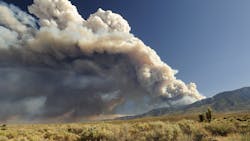West Coast wildfires can intensify storms in Central U.S.
A new study finds that wildfires burning in the West Coast states can strengthen storms in downwind states.
The paper, published in the journal Proceedings of the National Academy of Sciencesand reported by the Pacific Northwest National Laboratory, says that the heat and tiny airborne particles produced by wildfires can distantly intensify severe storms. In some cases, this can bring baseball-sized hail, heavier rain, and flash flooding to states like Colorado, Wyoming, Nebraska, Kansas, Oklahoma, and the Dakotas.Typically, western wildfires and storms in the Central U.S. are separated by seasons. As blazes begin earlier each year, however, the two events now strike closer together.
Earth scientist Jiwen Fan, a laboratory fellow at the Department of Energy’s Pacific Northwest National Laboratory, began investigating a relationship between the two phenomena when she noticed that the West’s 2018 wildfires overlapped with storms in the Central U.S. She found that both events occurred simultaneously for a week. Looking further, Fan found it was the first time these storms and wildfires had concurred in 20 years where storms lasted over four days.
Her team used data describing the storms’ hailstones and rain levels, as well as the fires and smoke plumes, to explore a possible mechanism behind the connection. The group used weather models that track heat and smoke particles to explore how the fires could remotely influence weather.
“We need to be careful and informed,” says Fan. “The more we understand about the contributing factors behind storms like this, which cause massive property loss, the better we’ll be able to prepare for them. And, as we look at the future climate, we know wildfires will increase, particularly in the West.”
“Severe storms in the Central U.S. are also projected to increase,” Fan adds. “Therefore, it is reasonable to expect that these co-occurring events would happen more frequently, and the impact of western wildfires on central storms may become increasingly important in the future.”
From Fire to Rain
As wildfires burn, these fires release incredible levels of heat. Some of the blazes, for example, warmed the fire area 10 to 40 times hotter than typical background temperatures in July. They also release billowing smoke particles, called aerosols.
That heat creates a strong difference in air pressure. Near the fires, air pressure is high. In the stormy Central U.S., air pressure is generally lower. As high pressure builds near the fire, the surrounding air flows toward lower pressure air, strengthening wind that already flows west to east.
Those stronger, westerly winds then carry smoke aerosols from western to central states. Along their journey, the winds pick up and carry atmospheric moisture, too. Now transported into storms brewing above the Central U.S., the greater concentration of moisture and aerosols kicks off a series of storm-strengthening reactions.
The aerosols provide extra surface area on which water vapor can condense. As the water condenses, it releases heat. This added heat provides energy that strengthens storms. When a storm is sufficiently strong, the condensed water droplets freeze and start to form hailstones.
Inside the storm, strong updrafts repeatedly lift the hailstones up. Every second a hailstone spends inside the storm is another moment it can collect more cooled water droplets, creating a bigger and bigger hailstone.
Local wildfires in the Central U.S. also strengthened the same storms, according to the study, but to a less significant degree. Those wildfires are much weaker than their western counterparts. Fan’s group plans to look for similar connections in other regions.
The findings could help inform future severe weather forecasts, says Yuwei Zhang, first author of the new study and a postdoc in Fan’s research team.
“The cost of the storms we studied exceeded $100 million in damage,” says Zhang. “If we know that distant wildfires contribute to stronger storms, that information could bring about better projections, which might help avoid some degree of destruction.”
The Carr Fire, which claimed a quarter of a million acres in California, and the Mendocino Complex Fire, which dealt $257 million in damage and burned 280 structures in the same state, were among the fires under study.


